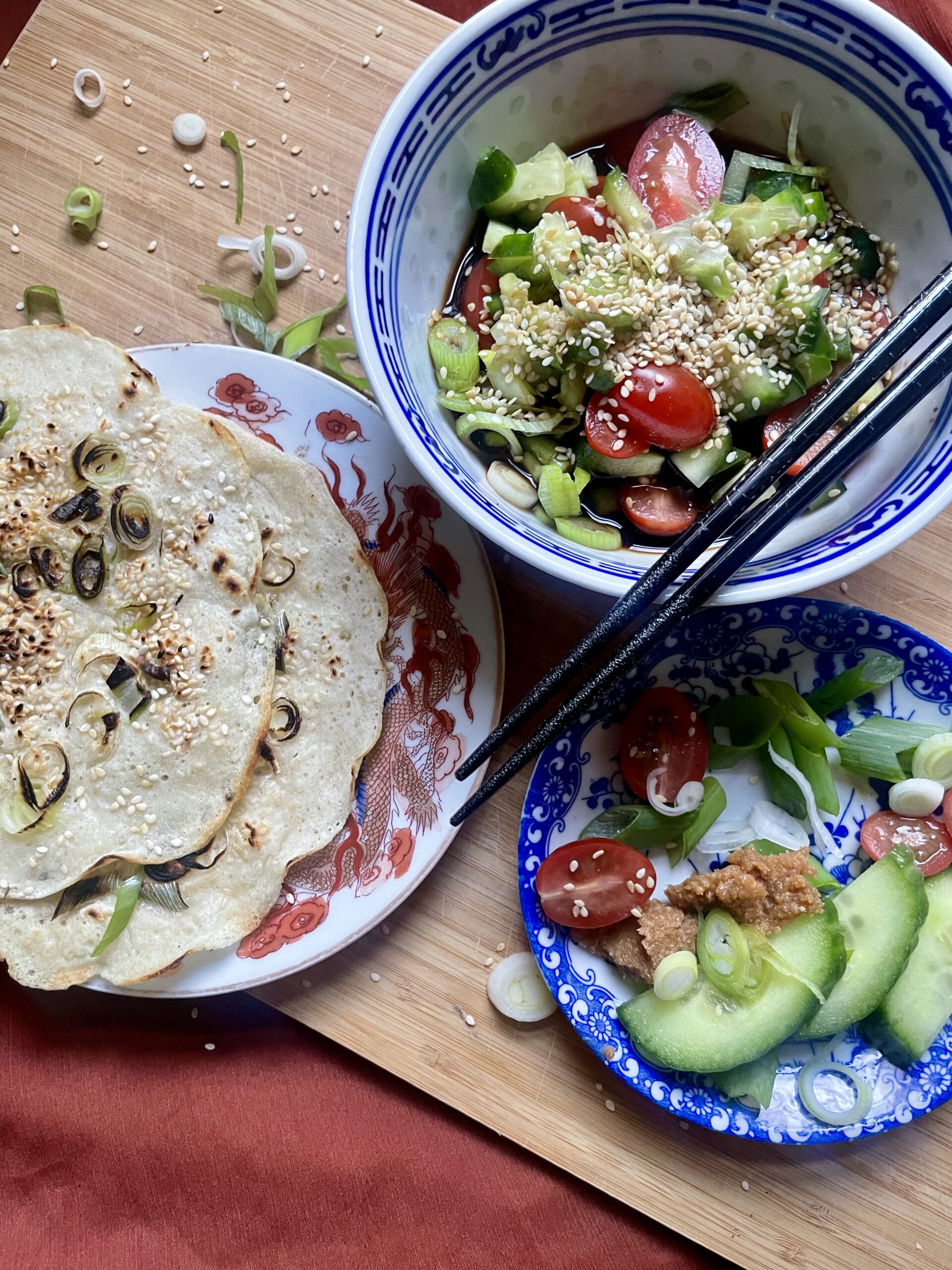POV: It’s lunchtime, and you have nothing prepped. You have a big glass of sourdough discard sitting on your counter top and a half an hour to feed yourself and everyone else.
Why you’ll love this recipe
You’ll use up your sourdough discard without turning on the oven.
It’s quick enough to fit into your 30-min home office lunch break.
You can make just enough for one person or scale up this recipe in a pinch.
Tips and Lessons
This recipe uses miso paste. I prefer the lighter versions of miso paste that are typically younger, as in less aged, and less intense flavour wise. You can get miso paste from any Asian grocer or buy it online in bulk. Miso paste keeps for a long time in the fridge and only grows more mature in taste. Because it is a fermented product, it rarely spoils.
Use a high quality soy sauce. Especially if you are using it as a condiment, you will taste the difference between the higher quality Korean or Japanese soy sauces and the generic ones that you will find in supermarkets. Buy a large bottle of Korean or Japanese soy sauce – this will be much more economical in the long run and make all the difference. There are some great options online as well.
Use a well-fed sourdough starter. Because the sourdough discard is not flavored or spiced in these pancakes, the natural flavor profile of the sourdough itself really comes through. If your starter is active and well-fed, you will have a wonderful tangy sour pancake. If your starter is not active, and you may have collected some hooch, steer away from this recipe until you have a happier, more active starter.
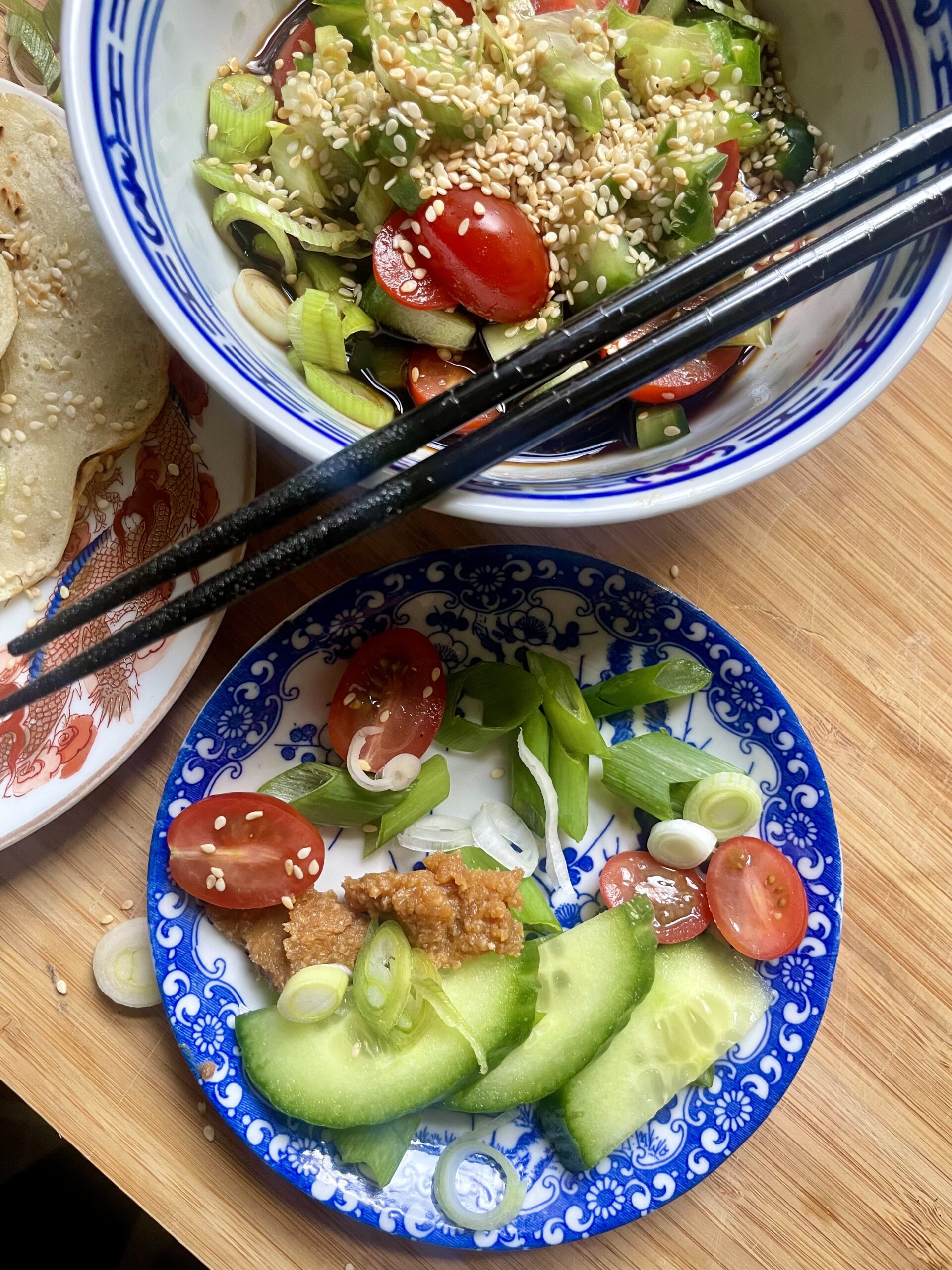
Swaps and Alternatives
Swap out the cucumber and tomatoes for fresh vegetables you have on hand. Julienned carrots, sliced bell peppers or thinly sliced radish make great alternatives.
No fresh produce on hand? Take it from the freezer instead: defrost frozen peas or green beans in a hot skillet and add to the dipping sauce.
If you have some dashi (Japanese broth) or self-made broth on hand, keep this handy to give your pancakes or dipping sauce extra depth.
A note on China and ‘Chinoserie’
Ever wondered, why China’s called China? Here’s a short history of the pretty plates:
Tea used to be a very expensive and exclusive drink that was exclusively imported to Europe from China. In the 17th Century ladies of the high society in the UK were the among the few that could afford it. They were greatly attracted to Chinese white porcelain and red pottery, coming to Britain on the same ships as tea it was importing from China. There was great demand for white translucent saucers and tea pots from China.
Ever wondered, why China’s called China?
Potters in Britain were keen to enter the lucrative tea pot market and imitated the Chinese designs. This imitation of Chinese white porcelain was so successful that porcelain was simply called ‚China.‘ This interpretation and imitation of traditional Chinese porcelain and pottery took creative licenses and diverged from the tradition of Chinese styles. More often than not, the European porcelain that imitated Chinese styles was based on imagined references and motifs.
Chinoiserie: European imaginations of China
Craftspeople with little knowledge of China began to make pottery that they believed looked Chinese, often with no access to the real thing. This gave rise to what is now called ‚Chinoiserie’ a trend that describes the style of porcelain that became popular in Europe based on the European imagination of what Chinese porcelain was like. By the 19th Century ‚bone china‘, made from ground animal bones was being crafted into elaborate tableware by European craftspeople. The same basic recipe is still being used by manufacturers today.
While European fascination with and imitation of Chinese porcelain was so popular that porcelain – to this day – is named China, some historians argue, that Chinoiserie is a problematic trend.
Just as important as the history of the food we serve, is the history of the plates and dishes we serve it on.
Critics of Chinoiserie point out that the European imagination of what Chinese porcelain looked like and the motifs on it were shaped by orientalist and derogatory views of Chinese people and culture.
What’s it to me?
Because while I adore Chinese pottery that is authentically from China and appreciate Chinoiserie as an aesthetic, it’s important to me to acknowledge the long and complicated history behind it. I cannot say for sure, whether my serving dishes are authentically Chinese or European imaginations of Chinese porcelain – I can however be mindful of this wrought history, behind the pretty plates.
Read up on Chinoiserie ⤵
If you’re interested I recommend this Netflix documentary. It’s a bit dated but the information is very intersting. Watch it here.
If you want to read more about the trend and style of Chinoiserie, check out this article by the British Victoria and Albert Museum. Read it here.
Ingredients
- 1 cup discard from an active starter, preferably fed with all purpose flour
- handful of chopped chives or spring onions (optional)
- tablespoon of sesame (optional)
- dashi or self-made broth (optional)
- neutral cooking oil to grease the pan
For the dipping sauce
- half a cup soy sauce or tamari
- 2 teaspoons of miso paste
- 1/3 cup diced cucumber (optional)
- 1/3 cup or a handful of diced cherry tomatoes (optional)
- 1/2 teaspoon of toasted sesame oil (optional)
How to make sourdough-discard pancakes with soy-miso-dipping sauce
Heat a skillet or pan and add a enough of the cooking oil to grease the pan. Make sure the skillet is very hot and the oil is evenly coating the surface of the skillet. I usually pour excess oil out and keep it for the next pancake.
Check the consistency of your starter, it should have the runny, smooth consistency of pancake batter. It it’s not hydrated enough, add your dashi or stock little by little until the discard has a smooth runny texture. If your discard is already very hydrated, don’t add more liquid.
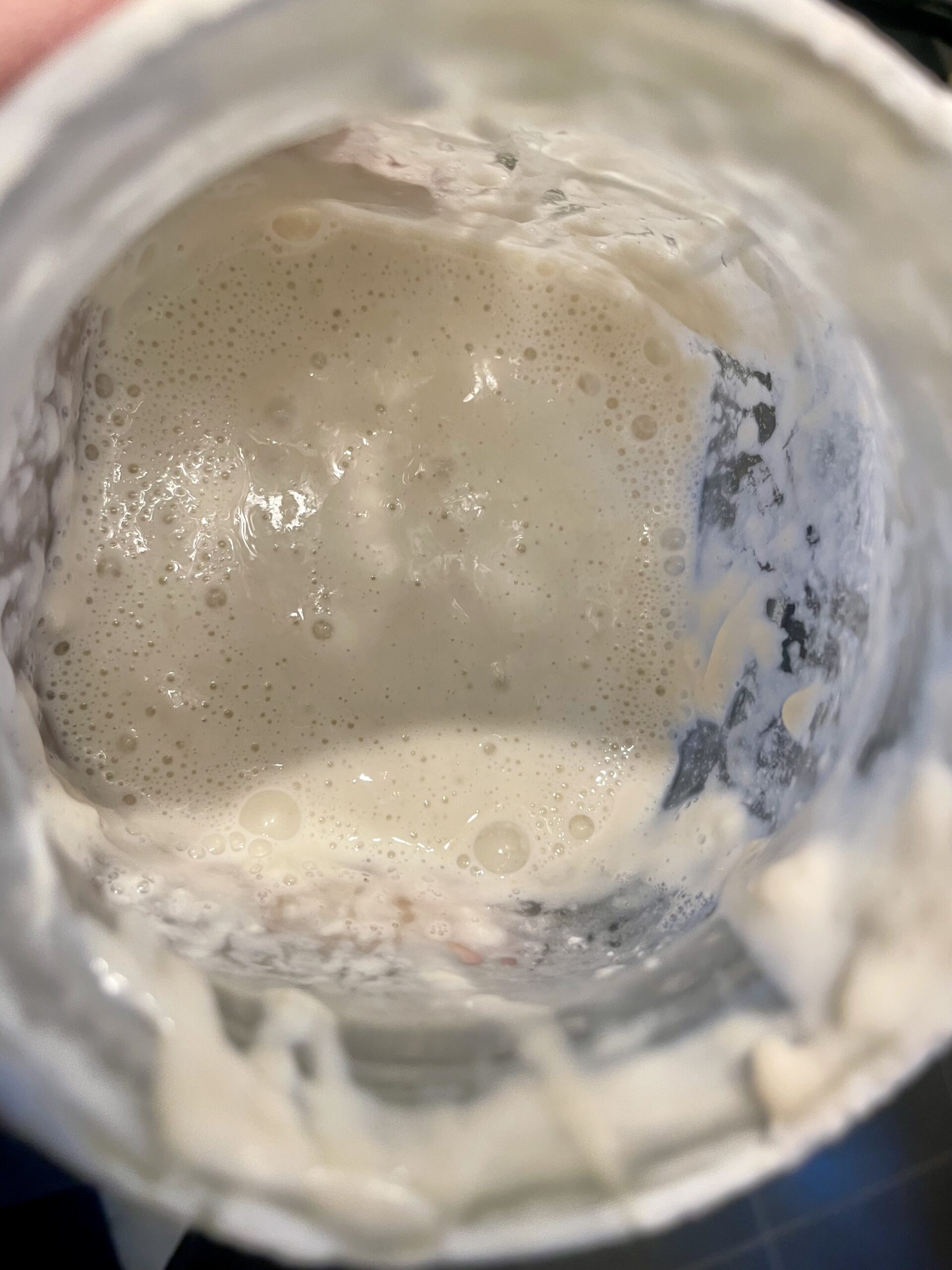
If using, chop the chives and or spring onions finely and set aside. Pour the discard into the heated skillet slowly until the liquid has filled the surface of the cooking surface. Try to make this layer as thin as possible. This will cut down the cooking time of your pancake significantly and make it more crispy.
If using, sprinkle the sesame seeds evenly onto the batter you just poured into the pan. The batter should still be uncooked, and the sesame seeds should sink into the uncooked surface of the batter slightly.
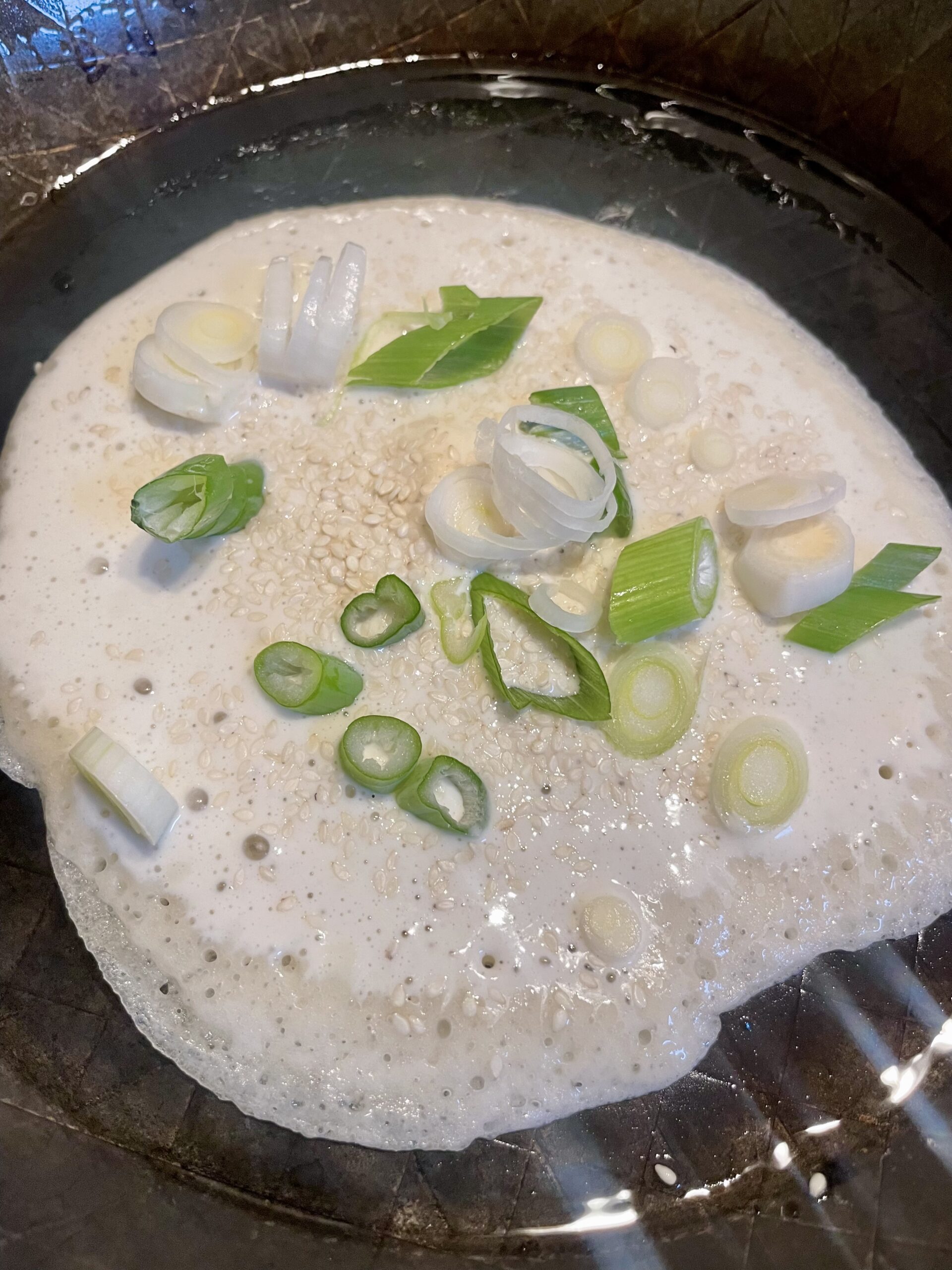
If using, quickly sprinkle the chives and spring onions onto the pancake as well.
Let the pancake cook for a few minutes over medium heat. The thinner your pancake, the quicker it will be done and ready for flipping. After a minute you should notice little holes forming on the surface of the batter. Turn down the heat a little to make sure you don’t burn one side while the middle is still cooking.
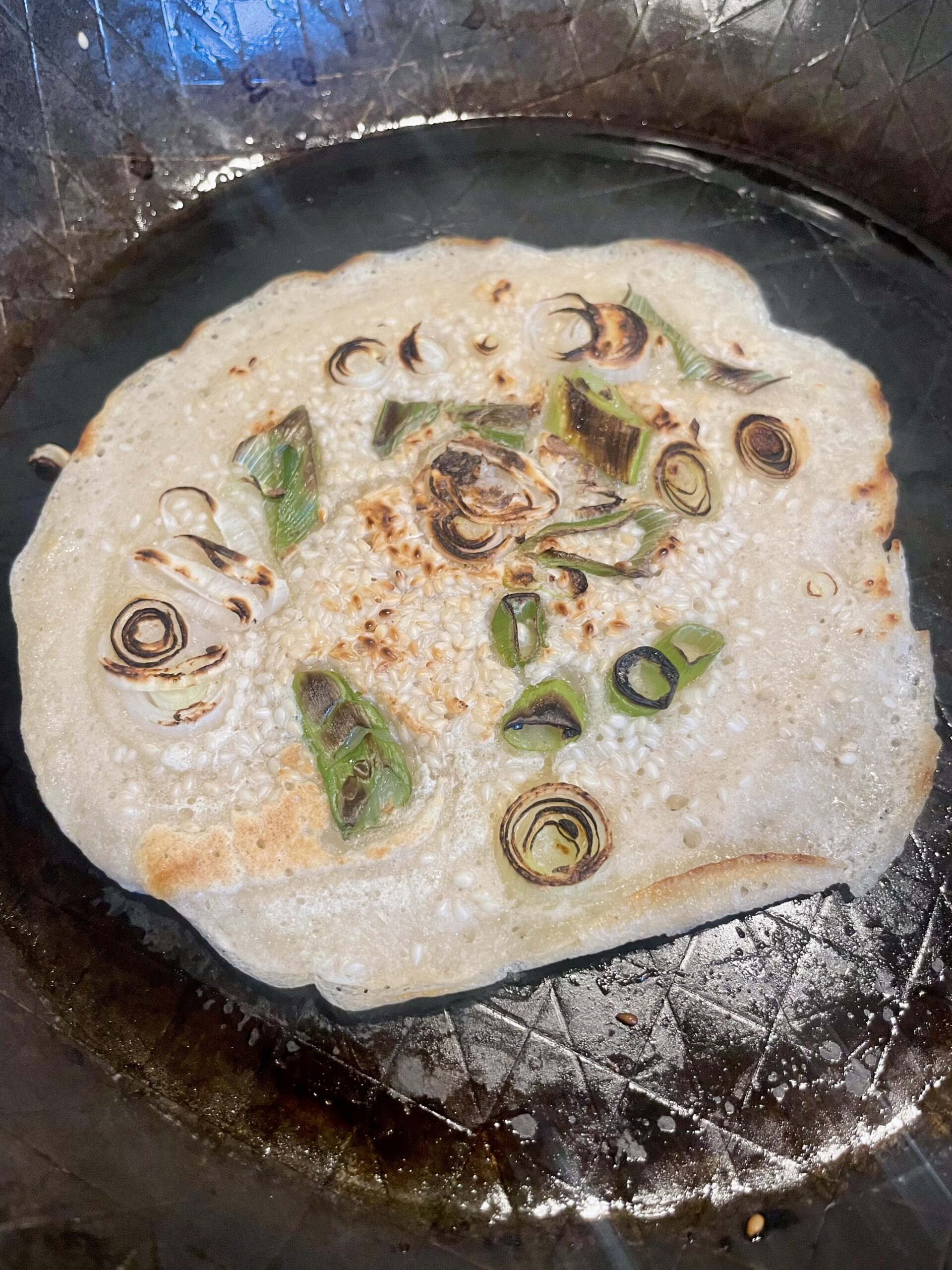
For the Soy-Miso Dipping Sauce
While the pancake is in the skillet, choose a small bowl for the dipping sauce and combine the miso paste with the soy sauce. Stir with a fork to break down any clumps of miso. Add the toasted sesame oil as well.
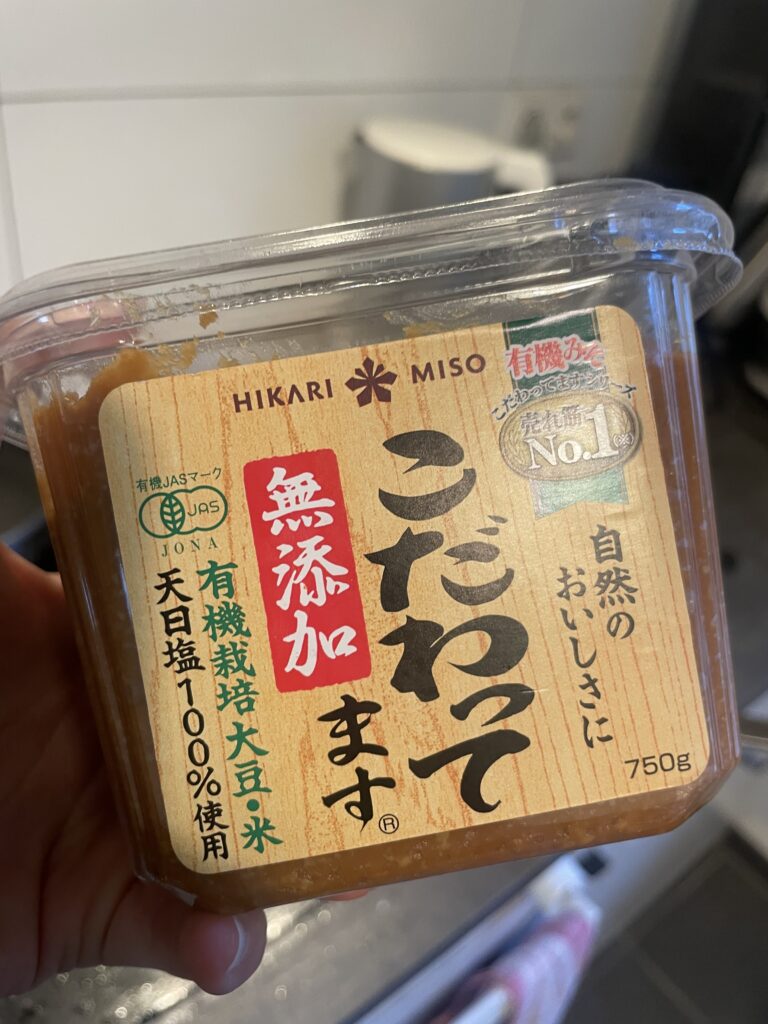
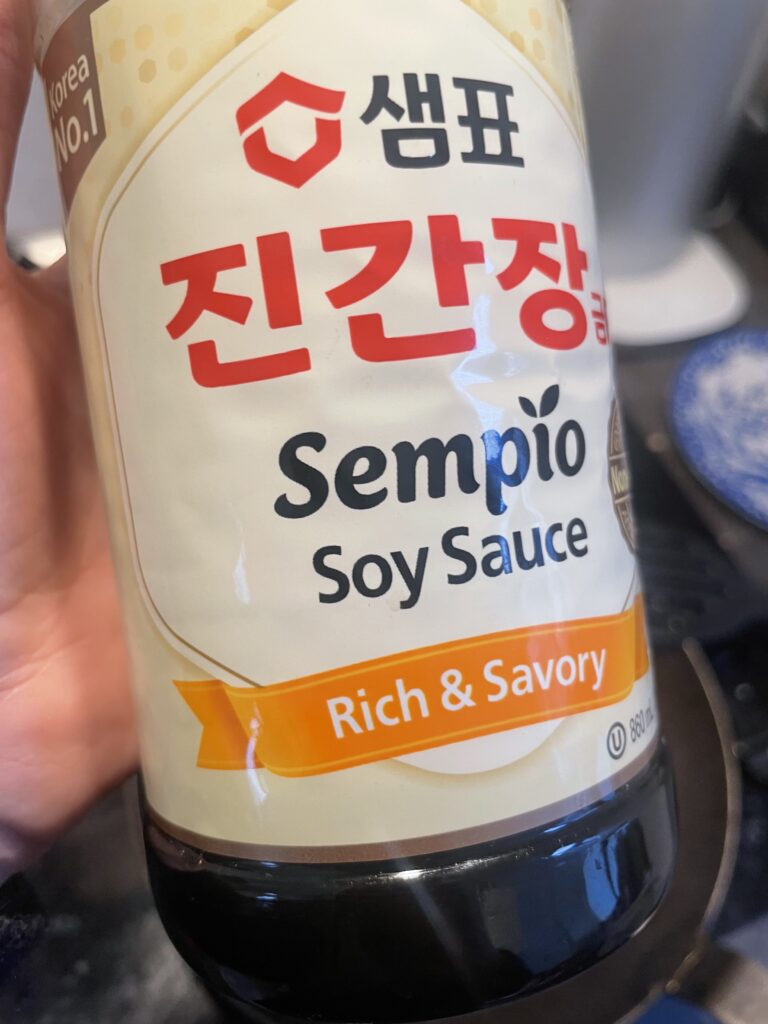
Chop the vegetables roughly and combine with the dipping sauce.
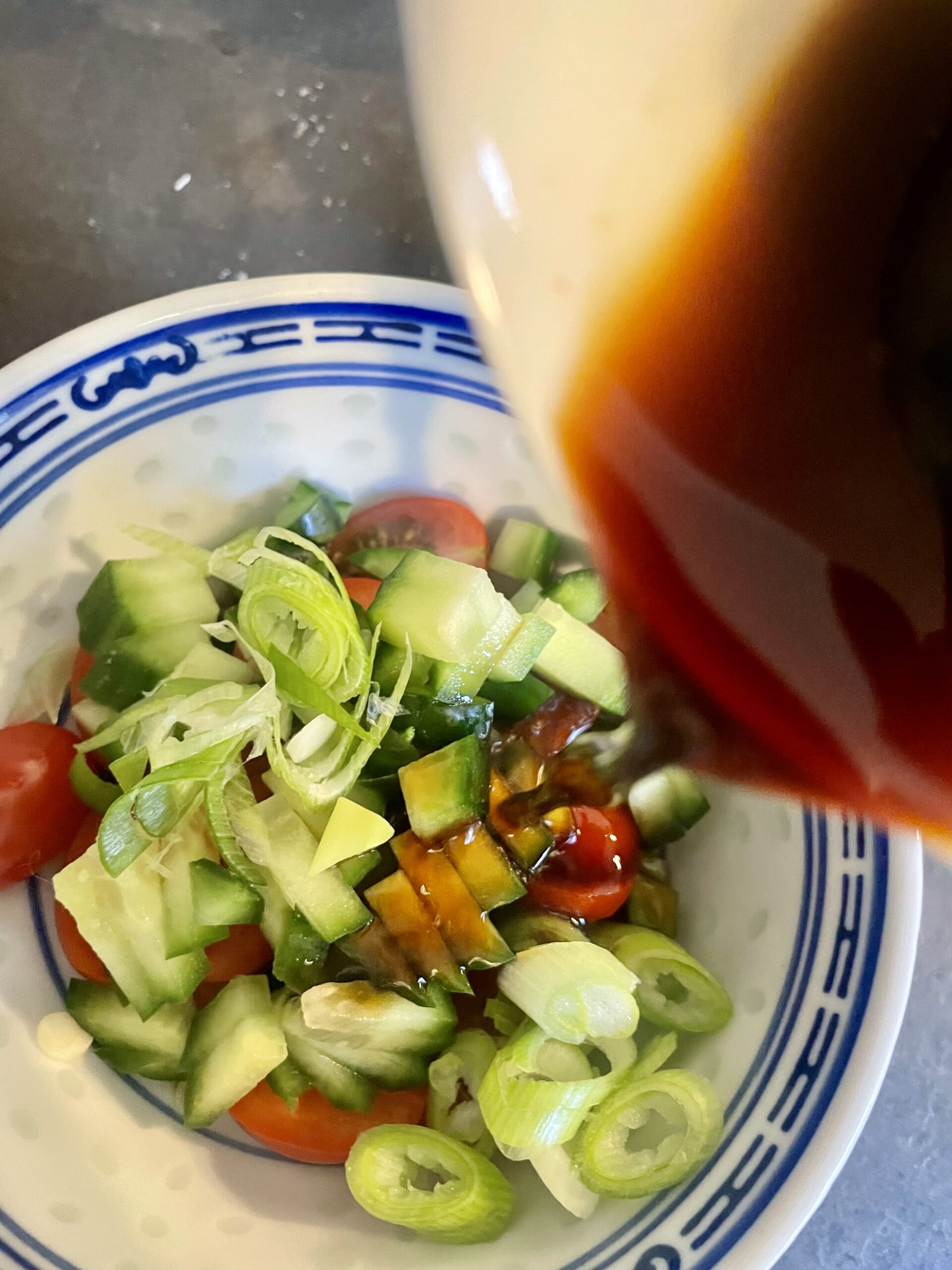
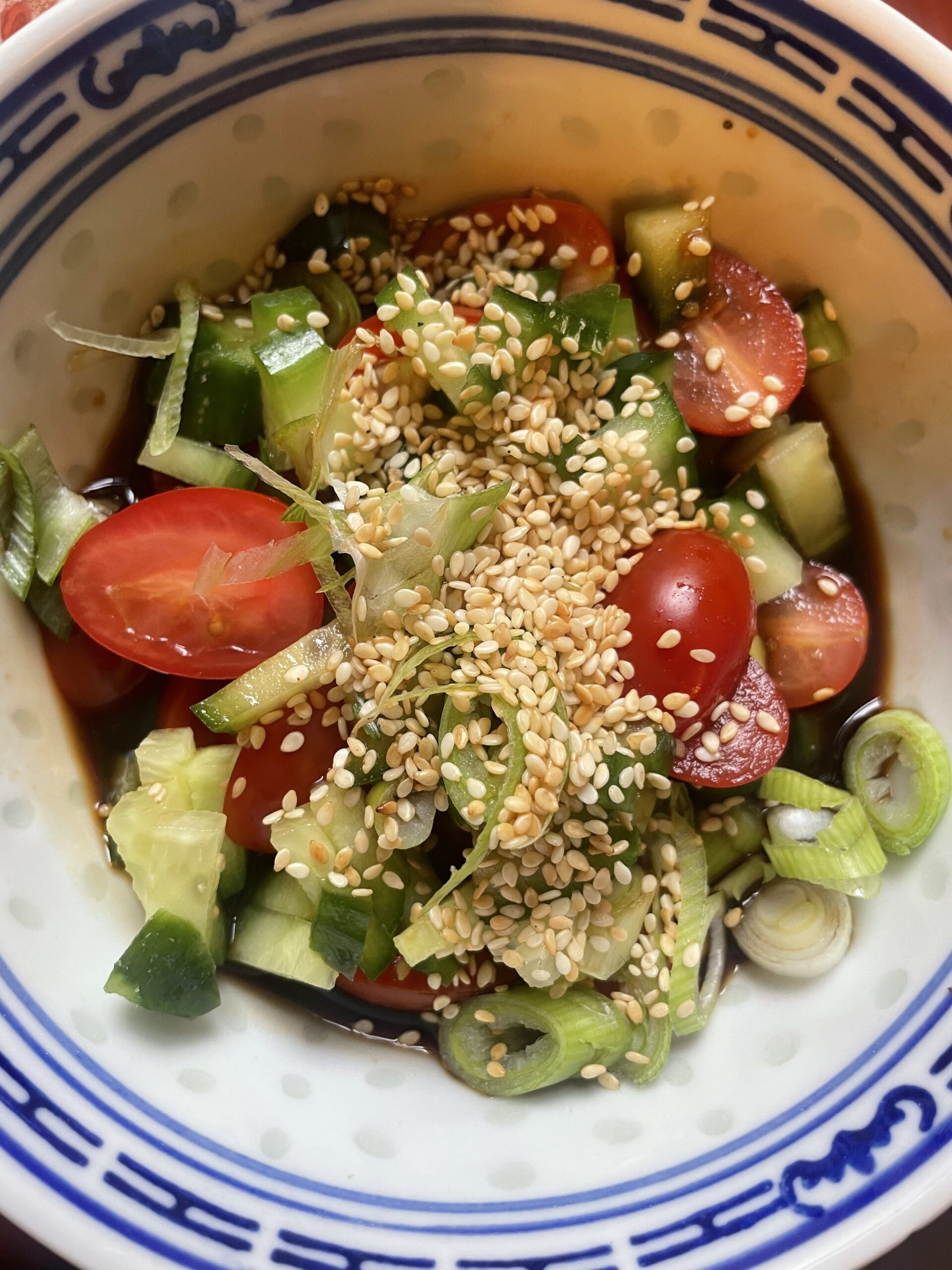
Flip the pancake and remove from the skillet once the edges are crispy and golden. Cut into pieces and serve immediately with the dipping sauce.
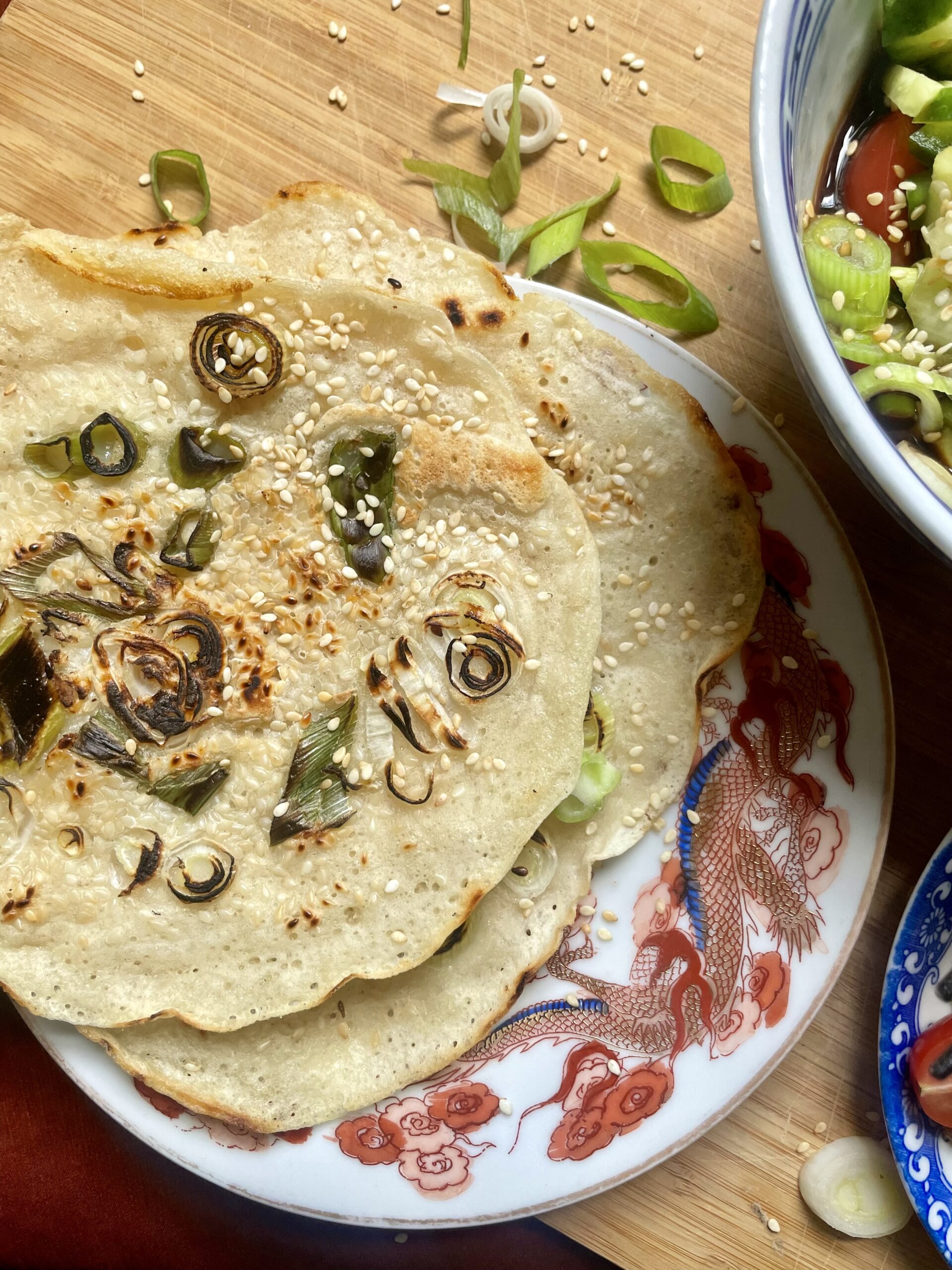
Have you tried making this recipe? Let me know below!
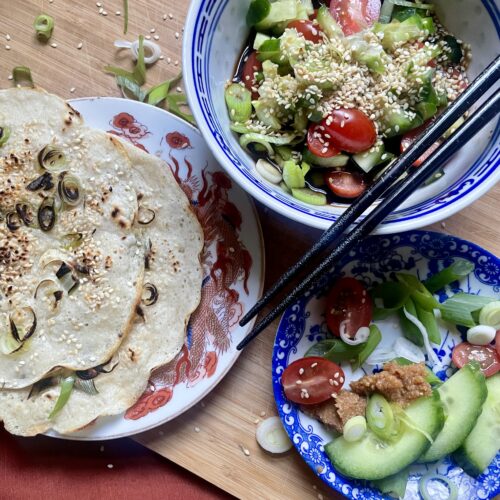
Sourdough discard Pancakes with Soy-Miso-Dipping Sauce (vegan)
Equipment
- 1 Large Skillet I prefer using a well seasoned cast-iron skillet for this. Alternatively, use a non-stick frying pan.
- 1 Bowl For serving
Ingredients
- 1 cup Sourdough Discard Use active and well-fed starter.
- 1 handful Spring Onions Optional, this really makes a difference to the taste.
- 1 tbsp Sesame Seeds Optional for garnishing your pancakes
- 1/2 cup Dashi or Broth Optional
- 1 tspn Neutral Cooking Oil To grease the pan
For the Dipping Sauce
- 1/2 cup Tamari, Soy Sauce or Coconut Aminos
- 2 tspn Light Miso Paste
- 1/3 cup Diced Cucumber Optional
- 1/3 cup Halved Cherry Tomatoes Optional
- 1/2 tspn Roasted Sesame Oil Optional
Instructions
- Heat a skillet or pan and add a enough of the cooking oil to grease the pan.
- Make sure the skillet is very hot and the oil is evenly coating the surface of the skillet. I usually pour excess oil out and keep it for the next pancake.
- Check the consistency of your starter, it should have the runny, smooth consistency of pancake batter. It it's not hydrated enough, add your dashi or stock little by little until the discard has a smooth runny texture. If your discard is already very hydrated, don't add more liquid.
- If using, chop the chives and or spring onions finely and set aside.
- Pour the discard into the heated skillet slowly until the liquid has filled the surface of the cooking surface. Try to make this layer as thin as possible. This will cut down the cooking time of your pancake significantly and make it more crispy.
- If using, sprinkle the sesame seeds evenly onto the batter you just poured into the pan. The batter should still be uncooked, and the sesame seeds should sink into the uncooked surface of the batter slightly.
- If using, quickly sprinkle the chives and spring onions onto the pancake as well.
- Let the pancake cook for a few minutes over medium heat. The thinner your pancake, the quicker it will be done and ready for flipping. After a minute you should notice little holes forming on the surface of the batter. Turn down the heat a little to make sure you don't burn one side while the middle is still cooking.
For the Dipping Sauce
- While the pancake is in the skillet, choose a small bowl for the dipping sauce and combine the miso paste with the soy sauce. Stir with a fork to break down any clumps of miso. Add the toasted sesame oil.
- Chop the vegetables roughly and combine with the dipping sauce.
- Flip the pancake and remove from the skillet once the edges are crispy and golden. Cut into pieces and serve immediately with the dipping sauce.
